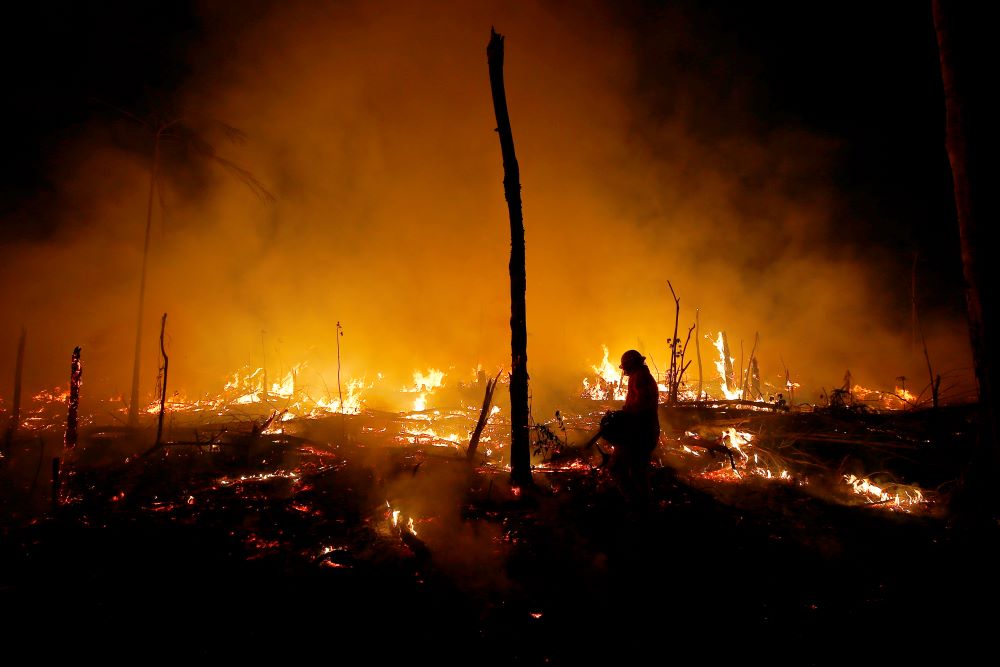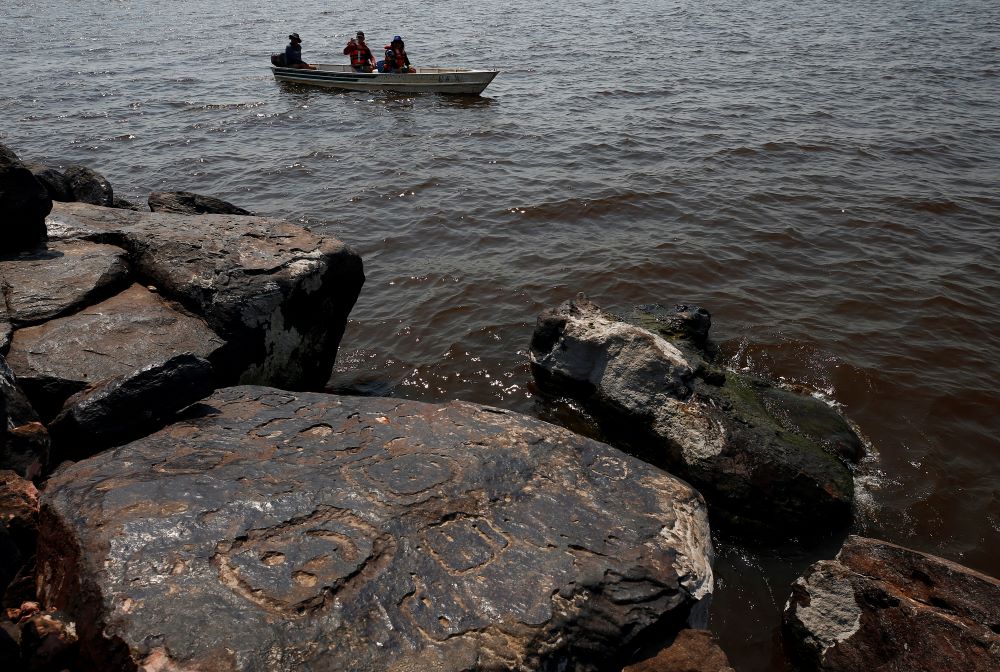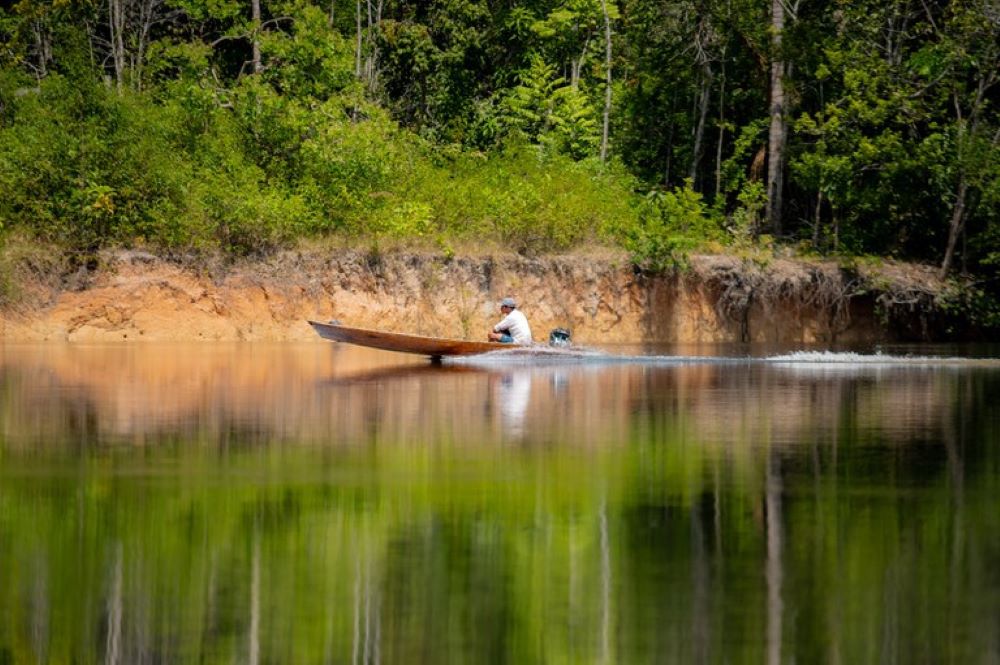
A resident of a riverside community carries food and containers of drinking water distributed due to the drought in Careiro da Varzea, Amazonas state, Brazil, Oct. 24. Hundreds of thousands of people were affected, and animals including dolphins and fish died as the region's water dried up. (AP/Edmar Barros)
An unprecedented drought severely impacted the lives of millions of people in the Brazilian Amazon in the last months of 2023. The situation was especially serious in the Amazonas state in the north, where dozens of riverside communities were isolated when river levels dropped too low for navigation. Lack of food and water affected the lives of many in the region in that period — and some of those consequences are ongoing.
According to the Amazonas state government, more than 600,000 people have been impacted by the drought since the beginning of October. All 62 cities in Amazonas state remained in a state of emergency in late January, even as the rainy season provided some relief. Poor communities, though, still feel the effects of the record drought.
In response, the church promoted donation campaigns to help the riverside communities and other affected groups. A national drive organized by the bishops' conference of Brazil and Caritas Brazil collected money to buy and distribute food and supplies for communities in Amazonas. Local dioceses also launched donation campaigns, including in Manaus, the state's capital city.
'The study of theological elements side by side with ecological themes is a way of putting the environment at the center of the mystery of creation.'
—Fr. Martin Islas
"The streams have dried up and the people don't have water for their crops. Cassava is a central element in their lives. Fishing became a hard task as well," said Bishop José Ionilton de Oliveira of Itacoatiara of the Prelature of Marajó.
The Amazonian streams and rivers are the roads of the riverside communities, he explained. When they are impossible to navigate, it's difficult for the people to go to the local villages and cities to buy food.
"In many locations, there is no available water of good quality for the people. As the rivers dry, the concentration of pollutants grows — especially pesticides thrown in the water by farms and heavy metals used in mining operations," he said last year.
According to Márcia Miranda, a Caritas coordinator in the region, many communities were drinking unsanitary water.
"Their water reserves dried up and all that's left in their wells is mud," she told EarthBeat.

This undated photo shows an aerial view of River Madeira with a very low water level during the worst point of the 2023 drought. (Courtesy of Porto Velho city government/Leandro Morais)
The extreme weather also led to the deaths of aquatic species all over the region, Miranda said. In lakes in cities like Tefé and Coari, dozens of Amazon river dolphins, a threatened species, have died.
"Studies showed that the high temperature reduced the levels of oxygen in the water. Heat and low oxygen have been killing fish and other animals. The consequences of that situation will continue to be felt for a long time," she said.
The high temperature affected the fish's reproduction and led to a high mortality, which will impact the schools of fish in future years, according to experts. Water mammals, like river dolphins, were already endangered, and the drought worsened conditions for them.
In Manaus, the largest city in the Amazon, the low level of the rivers complicated navigation. Companies had to cut production for more than a week, sending thousands of workers home.
Brazil's dry season was difficult in the city, too. In addition to high temperatures and low air humidity, Manaus residents periodically faced smoky air as a result of nearby wildfires in the rainforest.
"The other day, we couldn't even see the river as we crossed it to a nearby district," said Fr. José Alcimar Araújo, the vice president of the Archdiocese of Manaus' Caritas organization.

Firefighters work to put out a blaze in the Amazon forest during a drought and high temperatures in the rural municipality of Careiro Castanho, Amazonas state, Brazil, on Oct. 21. (AP/Edmar Barros)
Rain has dispersed the smoke on some days. But it takes only a couple days without rain for the clean air to disappear.
"Children and senior citizens have been suffering with the low air quality and clinics have been overcrowded with patients suffering from respiratory problems," Araújo said. People even resumed wearing face masks when they go out — common practice during the height of the COVID-19 pandemic.
For decades, the city of Manaus has grown without urban planning, and many people built their houses by small water streams (known as igarapés) which flow into River Negro.
"Many of the igarapés have dried up or present a rather low water level. Most of them receive sewage, which is now more concentrated. The smell is terrible," the priest said.
Araújo is working on a project to promote the sanitation of small rivers and igarapés to avoid the contamination of the region's larger rivers. He plans to present it to potential funders this year.
"We have also been discussing the consequences of the drought in the archdiocese's Integral Ecology Commission. It must be clear that all that crisis has been provoked by human action," he said.

Rock paintings are seen at the Ponta das Lajes archaeological site, in the rural area of Manaus, Brazil, on Oct. 28. The archaeological site was exposed following a drought in the Negro River, unveiling rock paintings that, according to archaeologists, date back between 1,000 and 2,000 years. (AP/Edmar Barros)
The Integral Ecology Commission was founded in Manaus earlier this year. Andreza Gomes Weil, an environmental studies professor at the Federal University of Amazonas, is a member. She explained that the group conducted research in all the archdiocese's parishes and communities to identify the ecological initiatives already in motion.
"We could see that it's still an incipient debate for the region's Catholics. People do have some awareness of the ecological problems in Manaus, but most of them don't see those issues as something that the church should work with," Weil told EarthBeat.
Advertisement
The commission's study also showed that most Catholics don't take part in the governmental councils in charge of discussing and making decisions regarding environmental policies.
"In more than 70% of Manaus' parishes, there is no participation in such councils, which are fundamental spaces of political participation when it comes to the environment," she added.
The commission now wants to incentivize church people to meditate on such issues and carry out a more participative relationship with the groups and organs that define environmental policies in Manaus.
"We need to change that situation. Cardinal Leonardo Steiner (archbishop of Manaus) has been incentivizing that parishes launch debates on our environmental conditions. Even catechism should include those themes, he argued," Weil said.

An undated photo shows the low level of an Amazonian stream during the 2023 drought. (Courtesy of government of Brazil/Rodrigo Cabral)
Mexican-born Fr. Martin Islas, who lives in Humaitá, believes that the Amazonian church should make a special effort to raise awareness on environmental themes through biblical-ecological education.
"The study of theological elements side by side with ecological themes is a way of putting the environment at the center of the mystery of creation," he told EartBeat.
In his opinion, "the environment should be understood not only as something that is external to individuals, given that it's part of the spiritual and social dimensions of existence."
In Humaitá, River Madeira has been continually polluted by the chemicals used in mining operations. The intense circulation of boats also results in more pollution, with oil and gas continually thrown into the water. The city's sewage is launched into the water as well.
"Education should begin with children and teenagers, so we would train the next generations to develop their own ecological vision of the world," Islas said. "I fear that changing the current generation's thinking is a difficult task at this point."








